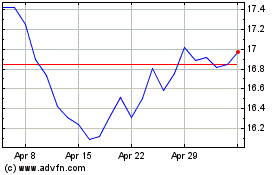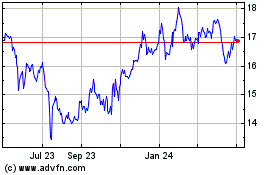By Ian Lovett and Drew FitzGerald
BREAKING
The man believed to be responsible for Friday's bombing in
downtown Nashville perished in the explosion, Nashville's police
chief said Sunday.
Anthony Quinn Warner, 63, owned the recreational vehicle in
which a bomb was set off outside of an AT&T switching station,
injuring at least three people. Authorities said they are still
searching for a motive in the attack, which damaged at least 41
buildings.
(Story below will update)
The person who set off a bomb in a recreational vehicle in
downtown Nashville early Christmas morning was likely motivated by
a desire to damage a nearby AT&T switching station, the mayor
of Tennessee's biggest city said Sunday.
Speaking on CBS's "Face the Nation," Nashville Mayor John Cooper
said, "To all of us locally, it feels like there has to be some
connection with the AT&T facility and the site of the
bombing."
Intelligence officials have considered whether the AT&T
building was targeted in the bombing, according to a person briefed
on the investigation.
Also Sunday, authorities in Rutherford County, outside
Nashville, said they were investigating a box truck discovered in a
parking lot that was playing similar music to what was heard from
the RV before it exploded.
Federal and local investigators have identified a 63-year-old
local man, Anthony Quinn Warner, as a person of interest in the
case, law-enforcement officials said Saturday.
Authorities are analyzing body tissue found near the scene of
the bombing to determine whether it belongs to someone who died
setting off the blast.
Steve Schmoldt, who lived next door to Mr. Warner since 1995,
said that for years, an RV that resembled the one authorities have
released photos of in connection with the bombing was parked
outside Mr. Warner's yard. About a month ago, Mr. Warner pulled the
RV inside a fenced area of his yard.
The RV is now gone from the property, Mr. Schmoldt said, and
federal agents showed up at the house Friday.
Mr. Warner worked at home and described himself as a "computer
geek," according to his neighbor. "He mostly kept to himself," Mr.
Schmoldt said. "I never saw anybody go to his house."
The bombing, which came after a sound system in the RV warned
listeners that an explosive was inside, injured at least three
people and damaged at least 41 buildings, one of which was
destroyed, according to authorities.
Damage to the AT&T switching station knocked out phone and
internet service in much of Tennessee, Kentucky and Northern
Alabama. The telecom company said Sunday that more than 75% of
mobility sites affected by the explosion had been restored and
portable cell sites were being used to help provide coverage in
other areas. Workers pumped more than 3 feet of water out of the
damaged building's basement, and 24 trailers with disaster recovery
equipment are en route as the company works to restore internet and
landline phone service.
Switching centers, also known in the industry as "central
offices," represent vulnerable spots in the country's
telecommunications infrastructure because of the important
equipment they house and how close they often are to busy downtown
business districts. Many are hulking brick-and-concrete structures
built several decades ago when the original AT&T monopoly
employed thousands of human operators to route customers' phone
calls.
Digital equipment later replaced those operator banks, but the
buildings continued to serve as hubs for hard-to-move fiber optic
lines that shuttle data. Access to the buildings is strictly
guarded, though their owners have less control of the environment
outside those centers.
Physical attacks on those network hubs are unusual. However,
telephone-pole wires and cellular towers are frequent targets of
intentional attacks. Gunshots and vandalism cause several dozen
outages in the U.S. each year, according to Federal Communications
Commission reports.
Such incidents rarely cause the massive outages that the latest
Christmas bombing created. The internet's decentralized structure
lets companies route around damage to other parts of the network.
An unknown attacker chopped several high-capacity fiber optic lines
in Northern California starting in 2014, for example, but the cuts
never interrupted service for long.
The center of Nashville's tourist zone is a few blocks away from
the explosion, along Lower Broadway, which is lined with honky
tonks and other music venues, cowboy boot stores, restaurants and a
museum dedicated to country music legend Johnny Cash.
More than 16 million people visited the city last year, 6% more
than in 2018, according to the Nashville Convention & Visitors
Corp. Visitors in 2019 directly spent about $7.5 billion in
Nashville, according to the business association.
This year, spending on tourism in Nashville is down about $4
billion, said Butch Spyridon, chief executive of the Nashville
Convention & Visitors Corp.
The organization was planning to air a television commercial at
the end of the month to lure tourists to the city, but now staff
are debating whether to pull the ad, according to Mr. Spyridon.
They have suspended all other advertising. Prospects for the city's
tourist business had been hopeful with vaccines being distributed,
but "this puts a wrench in the plans," he said.
Several times this year, Mr. Spyridon had thought Nashville
tourism was about to start recovering.
"But every time another blow is landed," he said. "We will work
our way out of this, but it just got harder and it just got
longer."
William Fox, an economist and director of the University of
Tennessee's Boyd Center for Business & Economic Research, said
Saturday that Tennessee's overall economy has weathered the
pandemic well but Nashville has struggled because of its dependence
on tourism.
Asked about the explosion's impact on the city's economy, Mr.
Fox said, "It won't really have a big impact. People will realize
pretty quickly that it's an isolated event."
Rachael Levy and Cameron McWhirter contributed to this
article.
Write to Ian Lovett at ian.lovett@wsj.com and Drew FitzGerald at
andrew.fitzgerald@wsj.com
(END) Dow Jones Newswires
December 27, 2020 17:34 ET (22:34 GMT)
Copyright (c) 2020 Dow Jones & Company, Inc.
AT&T (NYSE:T)
Historical Stock Chart
From Mar 2024 to Apr 2024

AT&T (NYSE:T)
Historical Stock Chart
From Apr 2023 to Apr 2024
